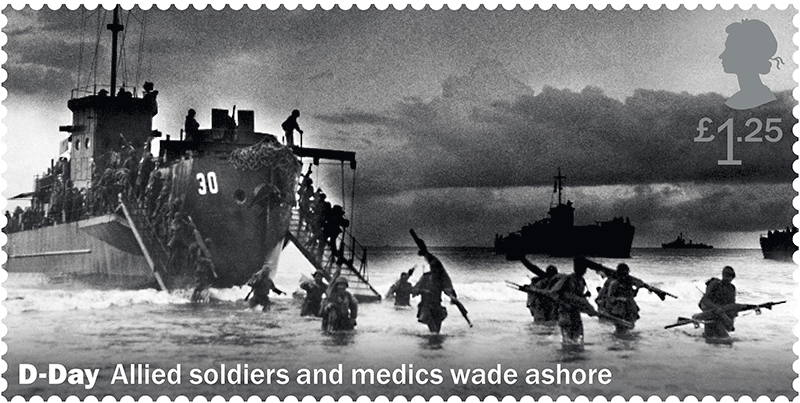Opinion by Lloyd A. de Vries
Royal Mail goofed.
As part of its preview of its 2019 “special” or “commemorative” stamps, it sent out what it said was a representative design for an issue of 11 stamps marking the 75th anniversary of D-Day. It turned out the sample design was erroneous and showed a different amphibious landing during World War II.
For the record, it showed the U.S. Coast Guard (not “Allied soldiers”) landing on May 17, 1944, at Sarmi in Netherlands New Guinea, now Indonesia. Here’s the design:  Royal Mail quickly sent out a correction, adding that the stamps had not yet been printed and, of course, this design won’t be printed.
Royal Mail quickly sent out a correction, adding that the stamps had not yet been printed and, of course, this design won’t be printed.
“End of story,” I thought. The mistake was caught in time, there are no “error design” stamps for collectors to seek and no economic penalty for Royal Mail of having to destroy already-printed stamps. I relabeled the erroneous illustration on my hard drive “not D-Day” and, since I hadn’t yet published the press release, I didn’t see the need for a retraction. End of (non-) story.
Boy, was I wrong!
I don’t know if it’s the times we live in, where any mistake by a public figure or agency must be trumpeted from the ramparts no matter how profuse the apologies, or if it’s the mindset of stamp collectors to seize upon any error or variation. Maybe it was just a slow news period. The incorrect D-Day stamp design became a hot topic in online discussion groups and a lead story in Linn’s Stamp News. All that’s missing is a formal complaint to the Royal Philatelic Society of London, and, for all I know, that is in the works.
I don’t know my history of wrong-design British stamps, but I can think of several design errors on U.S. stamps that did get printed and go on sale, including putting the Grand Canyon in the wrong state and showing Bill Pickett’s brother instead of the African-American cowboy in the Legends of the West sheet. Sending out a press release with an incorrect image pales by comparison.
Perhaps collectors are annoyed that the Sarmi stamps weren’t printed and they won’t be able to add them to their Mistakes On Stamps collections.
When the catalogues with the 2019 British stamps are published, I would hope this episode doesn’t even merit a footnote.
As someone who writes news for a living, I know first-hand that errors creep in all the time. You try to catch them, you hope someone else catches them before the mistakes are public, and when they do go public, you fix them. I would also estimate that 8 out of 10 major-newspaper articles I read on their websites have footnotes about corrections made. That is one of the disadvantages of the instant publishing made possible in this digital age.
Mistakes happen. This one was caught in plenty of time, with no real harm. It has already received much too much attention. Let’s move on.




The ol bulletin board (omg) that the old snipers were sounding off is where all the pissed off ol bastards hang out… you know your old board. To use anything said by old farts… some are thieves…. is ridiculous… who cares
One of the assets of the digital age is that research material is readily available online. For instance, there are currently over 300 images from the D-Day landings available to view on the Imperial War Museum’s website. If I could do that, why didn’t the Royal Mail?
I agree about moving on… Let’s move on to the subject of when will the USPS be announcing their stamp to commemorate the 75th anniversary of the D-Day landings?
There are less than 500,000, out of the over 16 million, who served during World War 2 still alive. Most likely, none will still be with us in 2044.